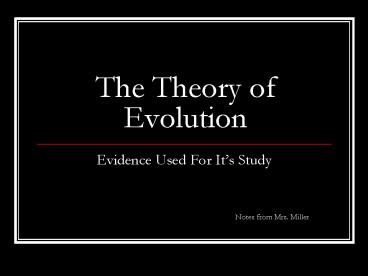The Theory of Evolution - PowerPoint PPT Presentation
1 / 15
Title:
The Theory of Evolution
Description:
Evolution: the theory that organisms change over time ... It is most developed among primates, in whom cognitive ability is the highest. ... – PowerPoint PPT presentation
Number of Views:206
Avg rating:3.0/5.0
Title: The Theory of Evolution
1
The Theory of Evolution
- Evidence Used For Its Study
- Notes from Mrs. Miller
2
Evolution Vocabulary
- Evolution the theory that organisms change over
time - Natural Selection Charles Darwins idea that
organisms with the best traits will live to
reproduce and pass on their genetic information - Adaptation a trait that enables an organism to
survive in the wild
3
Fossils
- Fossils are remains or traces of dead organisms
buried and preserved in sedimentary rock. - Fossils present a vivid record of the earliest
life on Earth, and of a progression over time
from simple to more-complex life forms.
4
Scientists have learned about prehistoric life by
studying fossils of ancient insects, such as this
midge fly, It was trapped in tree resin when it
was alive. The resin eventually hardens and
fossilizes into amber. Sometimes an entire
organisms is preserved in this manner.
5
Although trilobites became extinct over 200
million years ago, they left detailed casts in
the rocks where they died. This silica shale
formation shows several trilobites. Because these
primitive arthropods were typical organisms of
the Paleozoic era, a paleontologist may use them
to determine the relative age of the rock strata.
6
This fossil cast shows the remains of
Archaeopteryx, a birdlike dinosaur. It had teeth
and a long, reptile-like tail covered with
feathers. Archaeopteryx lived between 163 million
and 144 million years ago.
7
Distribution of Species
- How different species of plants and animals are
geographically distributed in nature, and how
they relate to their environment and to each
other is evidence of change over time. - Populations that exist on islands provide living
clues of patterns of evolution.
8
Darwin first observed the adaptive radiation of
the Galapagos finches. Finches living on
different islands changed over long periods of
time due to the different habitats or living
conditions.
9
The distribution of the worlds flightless birds,
reflects the shifting of continents (Plate
Tectonics). These birds supposedly shifted with
the continents too. Following this separation,
the flightless birds of each of these new
continents gradually evolved into one or more
distinct speciesthe ostrich of Africa (shown
here), the rhea of South America, and the
cassowary and emu of Australia.
10
Anatomical Similarities
- The study of the internal and external features
of different living things is known as
comparative anatomy. - It provides a wealth of information about
evolution.
11
Structures that are similar due to evolutionary
origin, such as the forearm bones of humans,
birds, porpoises, and elephants, are called
homologous structures.
12
All vertebrate brains share the same basic
three-part structure, the cerebrum, the
cerebellum and the brain stem. Their size and
development varies. In mammals, the cerebrum
dominates the brain. It is most developed among
primates, in whom cognitive ability is the
highest.
13
Vestigial Structures
- Some organisms have structures or organs that
seem to serve no useful function. These are
called vestigial organs or structures. - Human tailbone, appendix, body hair
- Male nipples in mammals
- Some snakes and whales tiny pelvic bones and
limb bones - Some cave-dwelling salamanders have eyes even
though members of the species are completely
blind. - Vestigial organs are often homologous to organs
that are useful in other species.
14
Embryology
- Comparison of the vertebrate development before
birth. - Gill pouches in both the bird embryo and the
human embryo. - A flexible notochord develops in the back.
- Blocks of tissue called will become muscle,
vertebrae, connective tissue, and, later, the
larger glands of the body. - Helps biologists identify like structures that
are less apparent in adults,.
15
DNA Amino Acid Chain Comparison
- DNAs uniformity organisms have the same
building blocks base pairing A w/T C w/ G. - Different combinations of these bases direct the
assembly of amino acids into functional proteins.
- DNA is thought to be a record of an organism's
evolutionary history. Scientists gain insights
into how different species are related by
comparing the same proteins from different
species. - In closely related species, the proteins vary by
only one to a few amino acids. - More distantly related organisms generally have
proteins with fewer similarities.































